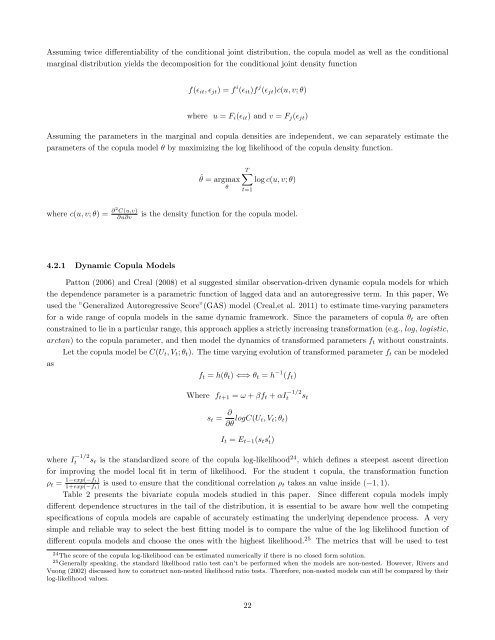Does Tail Dependence Make A Difference In the ... - Boston College
Does Tail Dependence Make A Difference In the ... - Boston College
Does Tail Dependence Make A Difference In the ... - Boston College
You also want an ePaper? Increase the reach of your titles
YUMPU automatically turns print PDFs into web optimized ePapers that Google loves.
Assuming twice differentiability of <strong>the</strong> conditional joint distribution, <strong>the</strong> copula model as well as <strong>the</strong> conditional<br />
marginal distribution yields <strong>the</strong> decomposition for <strong>the</strong> conditional joint density function<br />
f(ɛ it , ɛ jt ) = f i (ɛ it )f j (ɛ jt )c(u, v; θ)<br />
where u = F i (ɛ it ) and v = F j (ɛ jt )<br />
Assuming <strong>the</strong> parameters in <strong>the</strong> marginal and copula densities are independent, we can separately estimate <strong>the</strong><br />
parameters of <strong>the</strong> copula model θ by maximizing <strong>the</strong> log likelihood of <strong>the</strong> copula density function.<br />
ˆθ = argmax<br />
θ<br />
T∑<br />
log c(u, v; θ)<br />
t=1<br />
where c(u, v; θ) = ∂2 C(u,v)<br />
∂u∂v<br />
is <strong>the</strong> density function for <strong>the</strong> copula model.<br />
4.2.1 Dynamic Copula Models<br />
Patton (2006) and Creal (2008) et al suggested similar observation-driven dynamic copula models for which<br />
<strong>the</strong> dependence parameter is a parametric function of lagged data and an autoregressive term. <strong>In</strong> this paper, We<br />
used <strong>the</strong> ”Generalized Autoregressive Score”(GAS) model (Creal,et al. 2011) to estimate time-varying parameters<br />
for a wide range of copula models in <strong>the</strong> same dynamic framework. Since <strong>the</strong> parameters of copula θ t are often<br />
constrained to lie in a particular range, this approach applies a strictly increasing transformation (e.g., log, logistic,<br />
arctan) to <strong>the</strong> copula parameter, and <strong>the</strong>n model <strong>the</strong> dynamics of transformed parameters f t without constraints.<br />
Let <strong>the</strong> copula model be C(U t , V t ; θ t ). The time varying evolution of transformed parameter f t can be modeled<br />
as<br />
f t = h(θ t ) ⇐⇒ θ t = h −1 (f t )<br />
Where f t+1 = ω + βf t + αI −1/2<br />
t s t<br />
s t = ∂ ∂θ logC(U t, V t ; θ t )<br />
I t = E t−1 (s t s ′ t)<br />
where I −1/2<br />
t s t is <strong>the</strong> standardized score of <strong>the</strong> copula log-likelihood 24 , which defines a steepest ascent direction<br />
for improving <strong>the</strong> model local fit in term of likelihood. For <strong>the</strong> student t copula, <strong>the</strong> transformation function<br />
ρ t = 1−exp(−ft)<br />
1+exp(−f is used to ensure that <strong>the</strong> conditional correlation ρ t) t takes an value inside (−1, 1).<br />
Table 2 presents <strong>the</strong> bivariate copula models studied in this paper. Since different copula models imply<br />
different dependence structures in <strong>the</strong> tail of <strong>the</strong> distribution, it is essential to be aware how well <strong>the</strong> competing<br />
specifications of copula models are capable of accurately estimating <strong>the</strong> underlying dependence process. A very<br />
simple and reliable way to select <strong>the</strong> best fitting model is to compare <strong>the</strong> value of <strong>the</strong> log likelihood function of<br />
different copula models and choose <strong>the</strong> ones with <strong>the</strong> highest likelihood. 25 The metrics that will be used to test<br />
24 The score of <strong>the</strong> copula log-likelihood can be estimated numerically if <strong>the</strong>re is no closed form solution.<br />
25 Generally speaking, <strong>the</strong> standard likelihood ratio test can’t be performed when <strong>the</strong> models are non-nested. However, Rivers and<br />
Vuong (2002) discussed how to construct non-nested likelihood ratio tests. Therefore, non-nested models can still be compared by <strong>the</strong>ir<br />
log-likelihood values.<br />
22
















